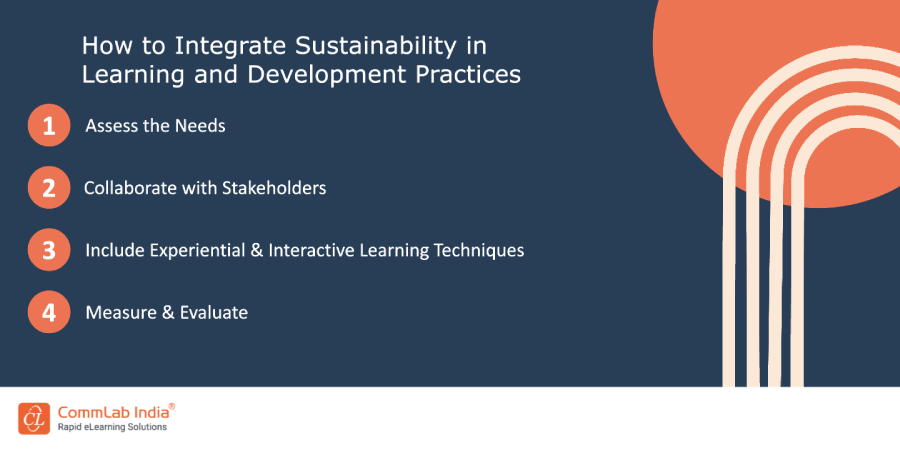A Path to an Equitable Future: Exploring 4 Vital Pillars of Sustainability in Corporate Culture

L&D Professionals play a crucial role in influencing the corporate environment and fostering good change inside the organization. Their focus must go to several important areas, including sustainability. It is now essential, not a choice, for businesses to embrace sustainability. We will discuss the four key pillars of sustainability in this blog, and you will gain some interesting tips and tricks on how to incorporate these principles in your corporate training and development programs.
Begin Your Journey Towards an Equitable Future by Integrating Sustainability Principles
The Four Pillars of Sustainability in the Workplace
- Promote resource conservation and encourage environmentally responsible behaviors
- Promote diversity, inclusiveness, and equal chances through training
- Promote financial knowledge and encourage moral business conduct
- Promote training initiatives to encourage ethical leadership in corporate governance
The Four Pillars of Sustainability in Corporate Environment

Environmental Responsibility
Environmental responsibility is the first pillar, and it includes actions that lessen their negative effects on the environment. By promoting resource conservation, increasing knowledge of environmental challenges, and supporting sustainable workplace practices, L&D professionals such as yourself can incorporate sustainability into their training programs. Giving employees eLearning-enabled training sessions in relevant subjects, like waste management, energy efficiency, and sustainable purchasing, can enable them to take responsibility for the environment in their jobs.
The key to integrating sustainability into training programs lies with L&D professionals, who should prioritize environmental responsibility as the primary pillar. Employees can actively help to reduce their negative environmental consequences by being informed about resource conservation, environmental issues, and sustainable workplace practices. Employees are given the tools they need to accept their part in protecting the environment and building a culture of sustainability inside the company through training in waste management, energy efficiency, and sustainable purchasing.
Social Equity
Social equity is the second pillar, and it focuses on inclusivity, diversity, and fair treatment within the organization. Through diversity and inclusion training, unconscious bias awareness, and encouraging a respectful and inclusive work environment, L&D professionals may advance social equity. L&D professionals can support an inclusive and socially responsible business culture by adding programs that address diversity, cultural sensitivity, and equal chances.
L&D professionals may promote social equality and effect positive change by putting diversity and inclusion training into practice, increasing awareness of unconscious prejudice, and creating a respectful and inclusive work environment. By implementing initiatives that address diversity, cultural sensitivity, and equal opportunity, they can support the development of an inclusive and socially conscious corporate culture. Through these initiatives, L&D professionals encourage fairness, foster diversity, and foster a workplace where everyone is valued and respected.
→ Download eBook: How L&D and Business Can Align to Conquer the Future of Work
Economic Viability
The third pillar, economic viability, is concerned with guaranteeing profitability while taking sustainability over the long term into account. Training initiatives that support monetary literacy, moral corporate conduct, and sustainable economic growth can be facilitated by L&D professionals. L&D professionals may support economic viability while connecting it with sustainable practices by educating employees about ethical financial management, sustainable supply chain methods, and socially responsible investment options.
L&D specialists support economic viability inside firms by conducting training initiatives that foster financial literacy, moral corporate behavior, and sustainable economic growth. By training employees in socially conscious investing opportunities, sustainable supply chain practices, and ethical financial management, they can make this easier. Training managers can contribute to the success of companies while upholding a commitment to long-term sustainability by providing employees with the information and abilities to make economically sound decisions that are in line with sustainable practices.
Ethical Governance
The fourth pillar, ethical governance, entails open and ethical decision-making procedures within organizations. By including courses on ethical leadership, corporate governance, and business ethics in their training programs, L&D professionals can integrate ethical governance. L&D professionals can support ethical governance and reinforce the moral foundation of the company by educating employees on ethical decision-making frameworks, encouraging an ethical culture, and offering advice on ethical conundrums.
By guiding employees through ethical dilemmas that may emerge, developing an ethical culture, and training employees in ethical decision-making frameworks, they have the chance to support and strengthen the moral foundation of the business. Through these programs, L&D professionals help the company establish a strong ethical foundation by ensuring that moral issues are considered in all decision-making processes.
In addition to boosting the organization’s credibility and reputation, L&D professionals who support ethical governance also help to create an environment where employees are more likely to act honorably and responsibly. Watch this video to explore a success story of eLearning aimed at sustainability in corporate settings:
How to Integrate Sustainability in Learning and Development Practices

Assessment of Needs:
To discover organizational gaps in sustainability-related training, do a complete requirements analysis. This assessment will assist you in modifying training courses to address specific issues related to sustainability issues and attain organizational objectives.
Collaboration with Stakeholders:
To make sure that sustainability programs and L&D strategies are aligned, collaborate with stakeholders like sustainability teams, HR, and senior management. Discuss the organization’s sustainability goals to better understand how to include them in training programs.
Experiential and Interactive Learning:
Design engaging and hands-on learning opportunities that provide learners the chance to practically investigate sustainability principles. Engage learners and assist them in making the connection between sustainability principles and their day-to-day job by using simulations, case studies, and actual situations.
Measurement and Evaluation:
Put in place procedures to gauge and assess the success of programs for teaching sustainability. To evaluate the success of sustainability projects, use criteria including knowledge retention, behavior change, and influence on key performance indicators.
Finishing Up
To promote positive change inside businesses, it is critical for L&D professionals to incorporate sustainability into their training and development programs. You may instill sustainable practices in your company by concentrating on the four sustainability pillars of environmental stewardship, social equity, economic viability, and ethical governance.
To impart environmental responsibility, promote resource conservation, waste management, and sustainable practices. To enhance social fairness, implement diversity and inclusion training, increase understanding of unconscious prejudice, and cultivate an inclusive workplace. By offering training in moral financial management and environmentally friendly business methods, you may support economic viability. Integrate corporate governance with training on ethical leadership to advance ethical governance.
By incorporating sustainability into your training, you help the environment, improve the standing of your business, and achieve long-term success. Download our eBook, “How L&D and Business Can Align to Conquer the Future of Work,” to understand how to integrate learning and development with the changing workplace. This will help your company get ready for the new environment.



![What are the Key Components of Sustainability Training? [Infographic]](https://blog.commlabindia.com/hubfs/blogs/sustainability-training-key-components-info.jpg)
![6 Tips to Make Compliance Training Fun and Exciting [Infographic]](https://blog.commlabindia.com/hubfs/blogs/compliance-training-making-engaging-infographic.jpg)
